was Tillandsia pretiosa
now Wallisia pretiosa (See DD02/17: for all new (DNA resolved) species & Cultivars.)
Click thumbnails for full size, scaled to a new window.
Wallisia pretiosa
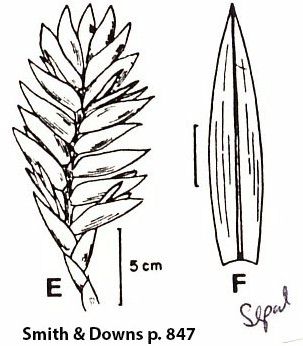

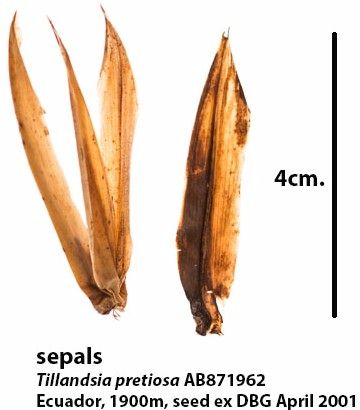
| Images via. Andrew Flower 2014 |
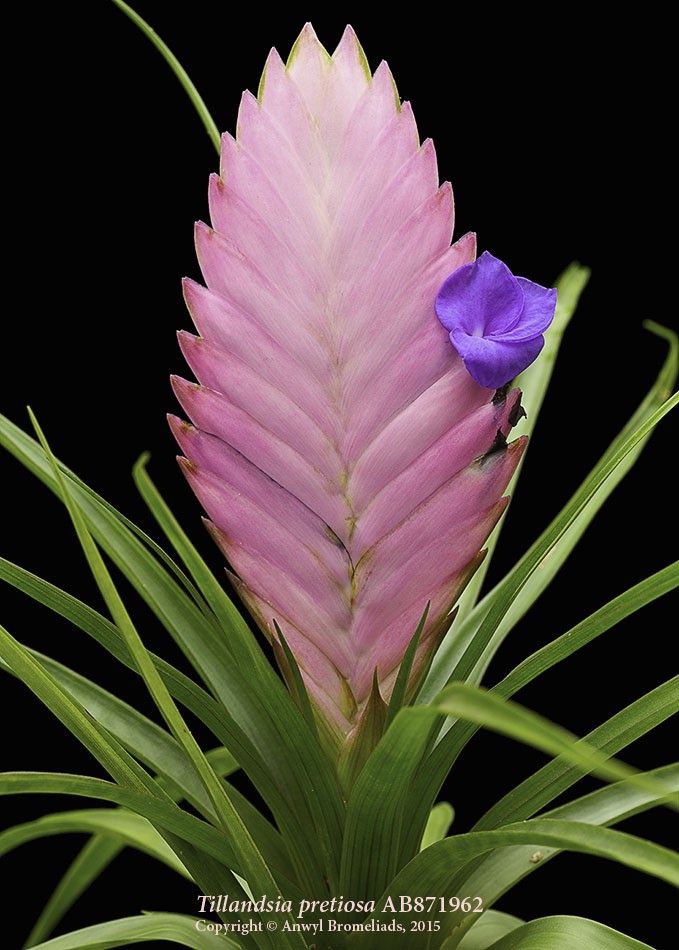


| Andrew Flower 05/16 |
Chris Larson 07/19 |
Andrew Flower ... "In June 2015 we discussed Tillandsia pretiosa - including my plant grown from seed collected in 1997 at 1900 m in Ecuador by a DBG member. At the time I didn't have a photo of this in flower, however it is now blooming here again - pics attached.
Derek Butcher was interested in the ratio of the inflorescence height to width:
My AB871962 infl. is 8cm wide, 16cm high - a neat 2-1.
Smith and Downs T. cyanea is 2.2-1; Rauh's T. pretiosa is 1.8-1.
Compared to the 2-1 ratio of this T. pretiosa, the Selby Gardens specimen shown last year in Peter Tristram's photos is considerably elongated.
One significant distinction between T. pretiosa and T. cyanea (Apart from the considerably larger flower in T. cyanea) is the tip of the sepals: short-pointy ("broadly acute") in cyanea, long-pointy ("acuminate") in pretiosa. So for reference I have attached my pic from last year showing the sepals on AB871962."
Derek Butcher ... "Thanks for photos. These have been added to the DVD.
Your concept of T. pretiosa links to the European current concept but I am interested in the Aussie plants which seem to be linked to Marie Selby. We must remember that Harry Luther placed Smith's T. cyanea var elatior as a synonym of T. pretiosa.
Things ain't simple when you get differing Botanist's opinions. You must have read the comments I make in the New Bromeliad Taxon list. Because of lack of input from the Americans, decisions made these
days have a more European flavour."
Chris Larson 07/19 ... "Recieved from Gordon Slack as "Tillandsia pretiosa imported Ecuagenera as umbellata 1996"."
Gordon Slack ... "I suspect your plant is the one I gave you along with some Pitcairnia seedlings at Burwood in May 2014. It was imported in 1996 from Ecuagenera as T. umbellata along with similar looking plants labelled T. caerulea (flowered as T. cyanea) & T. hamaleana which it is not but it has not flowered. These survived the gas unlike some orchids & other Broms. When it eventually flowered it was obviously not T. umbellata, nothing like my umbellatas from M K or P T or the image on p200 JBS 1981 vol 31. With due respect to Rauh, these umbellata inflorescences are not ensiform or dense (p266 JBS 1984 vol 34) to me. The leaves were much wider & longer than either T. cyanea or T. umbellata & had dense red-brown pigmentation at the leaf base. It was also completely different to a plant labelled T. pretiosa from Steve H (ex PT) which appears to be an average T. cyanea & similar to what has just been posted.
As it was not consistent with T. umbellata & closer than other members of this group to T. pretiosa I changed the label."
Andrew Flower ... "Thanks Chris. An interesting "paddle" development - does your plant always flower like this? Its been a while since mine flowered, but I'm pretty sure it has only one or two flowers open at the same time.
The only Tillandsia pretiosa I have was grown from seed collected at 1900m in Ecuador, and sent to me from the DBG (see pics above).
Please excuse me, I classify this taxon in Tillandsia subgen. wallisia. One day I might get around to an article explaining why, meanwhile write me off as a dinosaur!"
Peter Tristram ... "I didn’t think of Ecuagenera. I’ve never imported from them but undoubtedly have indirectly! Another clone! Regarding umbellata, Walter and Mike informed me that that taxon will remain, so keep your umbellata labels. I have plants from various sources, ex Selby, Tropiflora, Kent’s and Skotak. All are very similar except for the Kent’s clone which has much darker foliage and a very elongated scape. They are all very small compared to pretiosa and cyanea, but share the giant blue and white flowers of pretiosa."
Derek Butcher ... "Andrew Flower: But does Chris's plant have pointed sepals. Yours seem to follow Rauh. See below.
Tillandsia pretiosa, from Ecuador by Werner Rauh in J. Brom. Soc. 34: 266. 1984
Tillandsia pretiosa is a beautiful plant, very rare in cultivation, and known only from Ecuador in the valley of Mindo and the Pichincha region. We collected this plant in July 1983 in the Mindo Valley in a mist-forest at an altitude of 1700 m.
T. pretiosa belongs to the group of T. lindenii, T. umbellata (please see Journal 31(5): 200-202; 1981), T. anceps, and T. cyanea. The main difference between T. lindenii, T. umbellata, and T. pretiosa is, according to L. B. Smith, the surface structure of the floral bracts. In the first two these are prominently nerved, in T. pretiosa even more so. All three species possess simple, complanate, sword-shaped inflorescences with deep blue petal-blades with a white eye at the base. While the ensiform inflorescences are arranged in a single plane and are dense in T. lindenii and T. umbellata, they are lax in T. pretiosa after flowering.
Following is a short diagnosis:
Plant stemless, flowering up to 50 cm high.
Leaves densely rosulate.
Sheaths distinct, broad ovate, concolorous with the blades; these are linear-triangular, long attenuate, 2 cm wide, nearly glabrous.
Scape erect, shorter than the leaves;
scape bracts densely imbricate, the lower ones subfoliate, the upper ones with a reduced blade, abruptly acute.
Inflorescence simple, long ovate-acute, strongly complanate, up to 20 cm long and 11 cm wide, ± 18-flowered.
Floral bracts spreading at and after anthesis, scarcely concealing or covering the pale violet rhachis, up to 55 mm long, exceeding the sepals, carinate, even, glabrous, pale violet.
Flowers spreading up to suberect.
Sepals free, long-elliptical, acuminate, 4.5 cm long, the posterior ones carinate, pale violet to white.
Petals up to 8 cm long, with large, spreading, somewhat rolled-back, bright blue blades with a white eye at the base.
Style and stamens deeply included
Collection number: Rauh 60212, July 83.
I don't think much of your chances with subgenus Wallisia. It seems a case of Europeans versus others. We know the Mexicans plump for genus Viridantha instead of Tillandsia. We know they plump for extra genera to Hechtia which are better covered by subgenera.
Species is the basic unit in botany but I cannot find it defined in the ICN rules. Likewise genus is not defined either so we wait for a King Solomon solution."
Peter Tristram ... "Chris: Another form of pretiosa! The description needs updating, given the inclusion of cyanea var tricolor and the fact that floral bracts don’t always separate, the main distinguishing feature apart from habitat. Without location, we just guess!. As I said, I grew seed from crossing Selby ‘s 2 very different clones and they were spread far and wide. I know Maurice Kellett got a bunch. Some looked like ‘typical’ pretiosa, some more like cyanea var tricolor - funny that. As for umbellata, I have a half done article on it with info and pics from Hiro in particular, including habitat pics. I must revisit it, but I haven’t been to habitat in Ecuador so didn’t feel qualified. It was in response to the Wallisia tree, though I was told it has been decided to keep umbellata separate now."
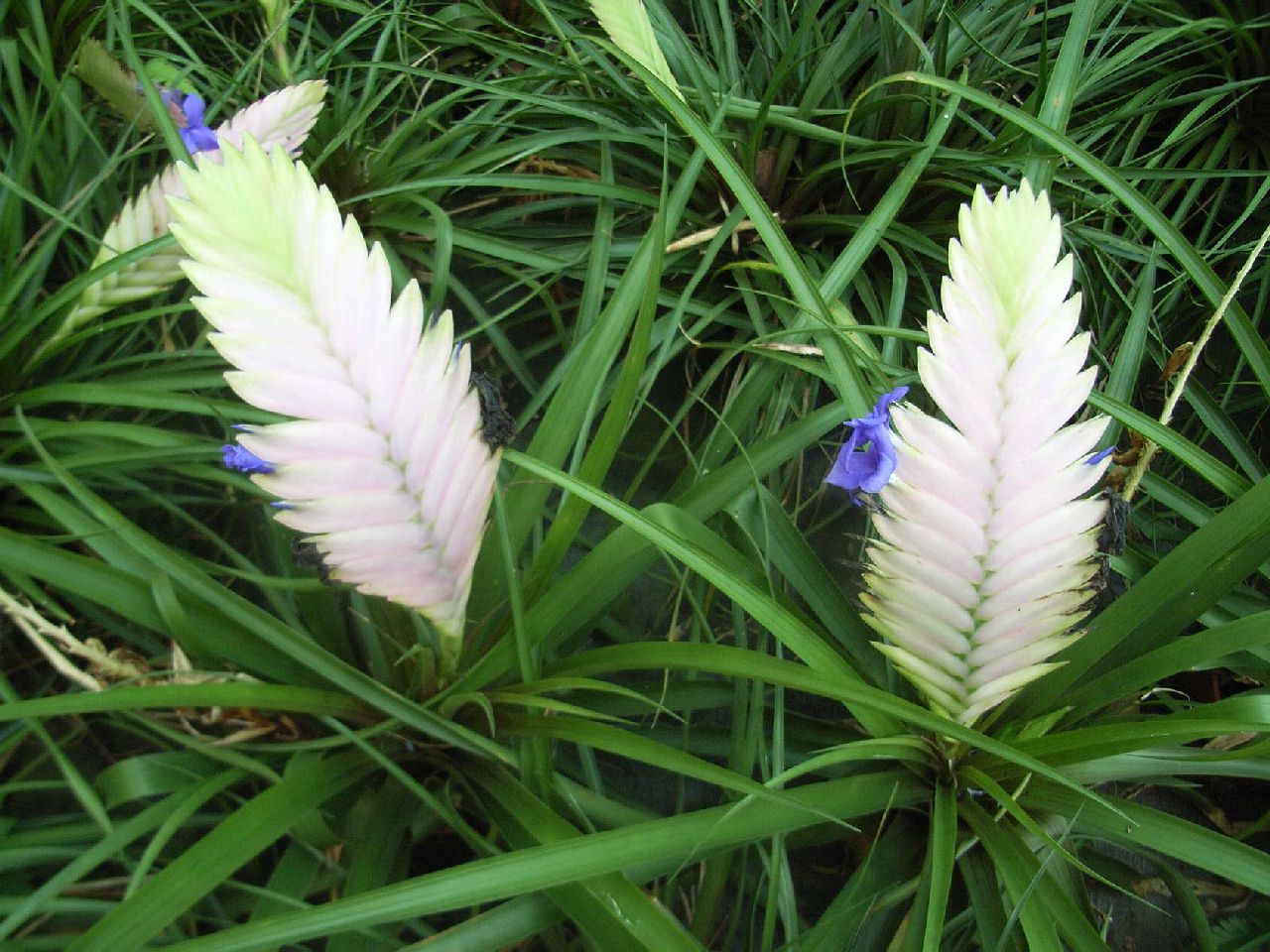
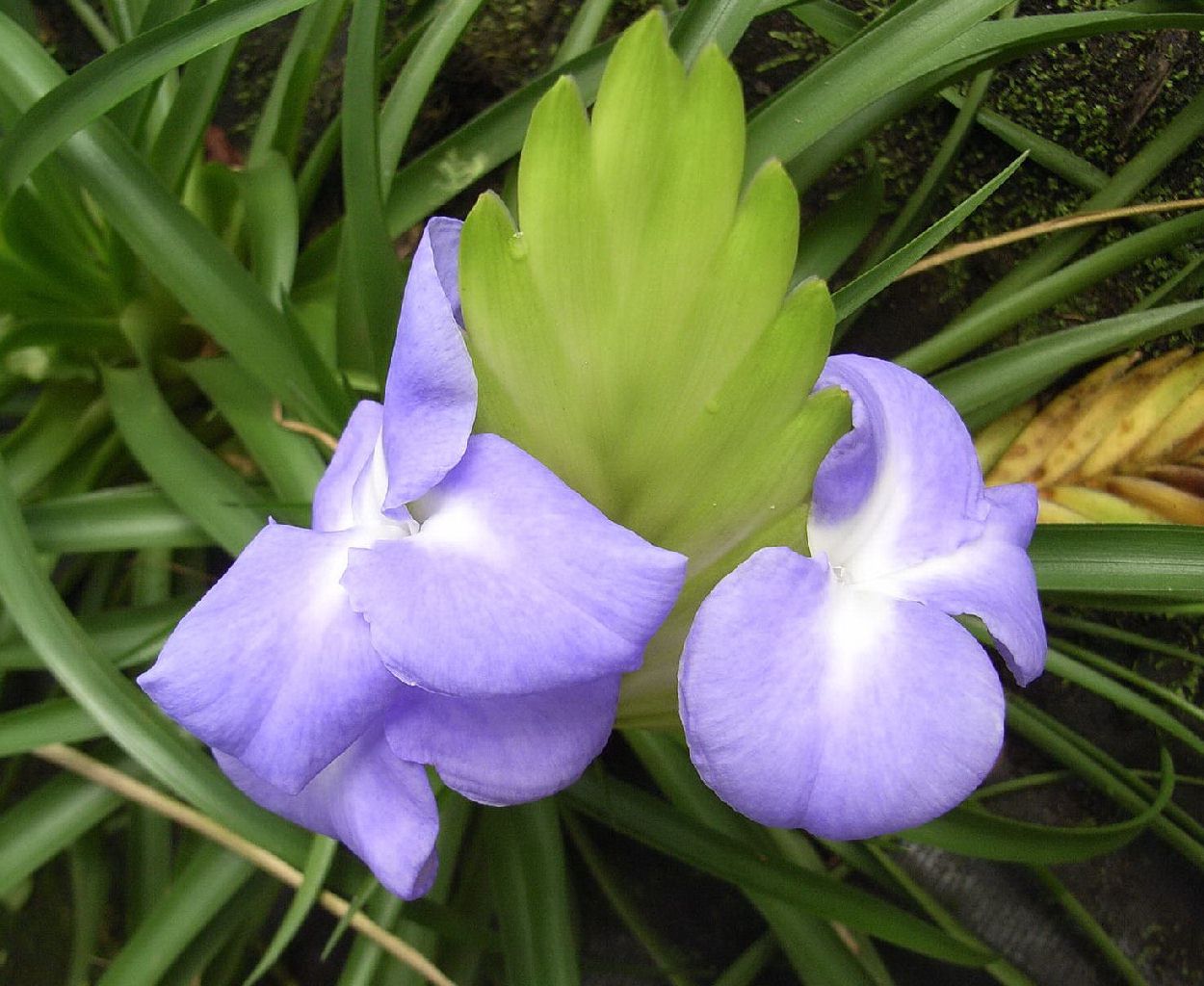
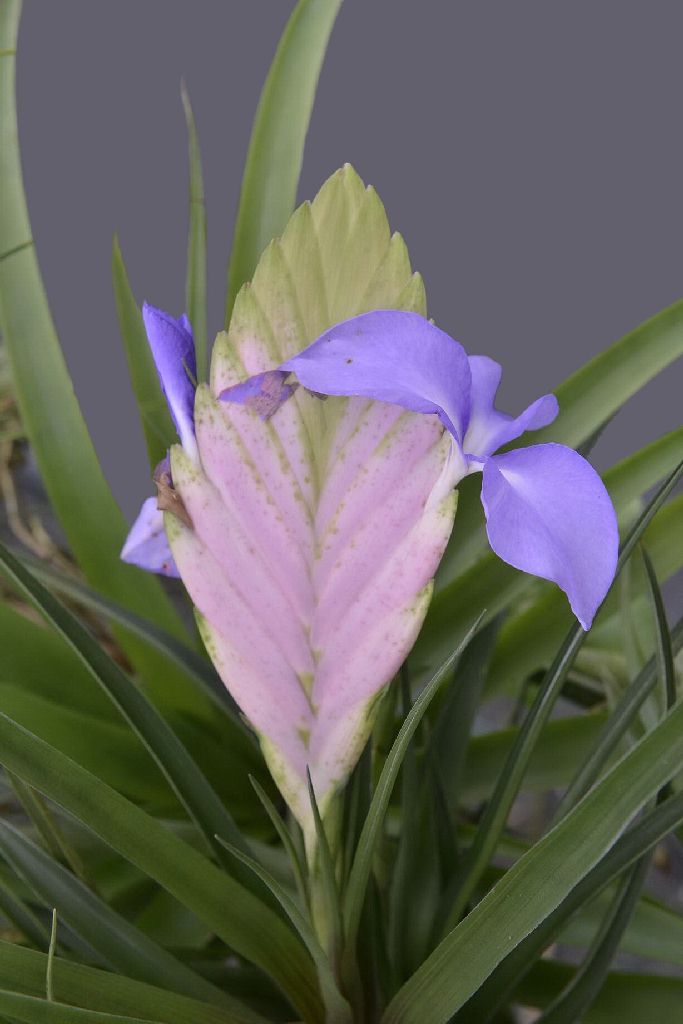
| Peter Tristram 07/19 ex. MSGB |
Peter Tristram 07/19 as cyanea var tricolor Tropiflora |
Peter Tristram ... "Most, if not all, of the T/W pretiosa in Australia originated from 2 plants that Harry gave me from the MSBG collection in 1988, which I crossed for seed. Dozens resulted. I still have the original 2 clones, one very large (see pic) and one much smaller, more like the T/W cyanea var. tricolor that I got from Tropiflora and Skotak a few years later (see pics of 2 clones above). Some colour bright pink in the bracts, some pale, some remain green. This has been synonymised with pretiosa now. Andrew Flower’s plant looks more like the ex cyanea var tricolor form which is more compact. All prefer shelter from hot summer sun (like me) and more frequent watering but are certainly hardy."
Tillandsias with Paddle-shaped inflorescences by D Butcher 2000
(anceps, cyanea, lindenii, pretiosa, umbellata)
There has been some interesting photographs submitted to the Internet about this group and it shows that there is some confusion as to names. First we have to ignore the use of colour purely because the beta cyanin in the blue petals creates havoc with colour film irrespective of brand and produces reddish tones. We have argued this point for many years in Adelaide and have never come up with an answer. I had thought that digital cameras might have solved the problem but it seems that the make of camera also effects the result. So the finer points of colour are out.
I thought I would solve this naming problem for good and all and draw up a chart. This follows:
| . Name | . Scape | . Spike | . Axis visible anthesis | . Petal | . White centre | . Floral bracts nerved |
| . anceps | . short | . 10-15cm x 5.5cm | . no | . 5.5cm long narrow and spreading | . no | . no |
| . cyanea | . short | . 16 x 7cm | . no | . 8cm long wide and spreading | . no except v. tricolor | . no |
| . lindenii | . long | . 20 x 5cm | . no | . 7cm long wide and spreading | . yes | . yes |
| . pretiosa | . long | . 20 x 11cm | . yes | . 8cm long wide and spreading | . yes | . very strong |
| . umbellata | . long and thin | . 6 x 3cm | . yes | . 7cm long wide and spreading | . yes | . yes |
The combinations should make it easy to pick out the species but do they? With such a colourful inflorescence, hybridists have been at them since the end of the 1800's and if the botanists couldn't identify the species, how could the hybridists know what they were pollinating with! So there are lots of problems out there!
From the botanist's point of view let me quote from Lyman Smith's Studies in the Bromeliaceae XVI (1951)
“The name, "Tillandsia lindeni", sets a new high for confusion in the Bromeliaceae. As used here it applies to the "long-scaped” species first noted by Regel, and not to the "short-scaped" species that E. Morren described as new under the same name. Regel, after publishing his species twice as "lindeni," for no explained reason changed to "lindeniana" for his third and best-known description, and a year later proposed "morreniana" as a new name for Morren's species to avoid duplication of the "lindeni" he now disowned. Morren, not to be outdone in weird reasoning, proceeded to make Regel's earlier species a variety "regeliana" of his, the later, "lindeni."
Regel and Morren argued back and forth in print over the names and status of their two finds and were later further confused by Andre. Meanwhile, the horticultural writers, struck by the great beauty of the plants, published a profusion of notes and illustrations without stopping to verify names and identities. In several instances they managed to illustrate "lindeni" of Regel while labeling it "lindeni" of Morren.
Regel contented himself in arguing the priority of his name and the specific distinction of the two entities involved. Morren considered them varieties of the same species and went on to add further varieties, still under the wrong "lindeni," with the paradoxical result that three of them must now be transferred from "lindeni" of Morren to "lindeni" of Regel, since the two species were founded independently, and on different types.
Again we meet confusion in the battle of Tillandsia lindeni. Both species were collected by Wallis and, as reported by Regel, one came from Zozoranga in Ecuador and the other from Huancabamba in Peru. Morren claimed that they were but a single collection, but later collections would refute this and also indicate that Regel had reversed species and localities. Actually, all collections since the types indicate that the species with the long scape is Peruvian and that with the short is Ecuadorian.
The earliest specimen of Tillandsia lindeni to be illustrated was few-flowered and rather resembled T. umbellata, but later more vigorous plants had larger inflorescences that contrast sharply with that species.”
After all this investigation you would have thought that Lyman Smith would have known all there was to know about this group but we find that his T. cyanea var. elatior is now treated as a T. pretiosa.
Let us also look at THE chart to see the differences between T. lindenii and T. pretiosa. The T. pretiosa spike is twice as long as it is wide, in fact quite a fat fellow, and in the photograph by Werner Rauh in BSIJ #6 1984 we clearly see the axis at the time of actual flowering. The photograph from Jose Manzanares is not as clear cut but it does show the non-flowered bracts at the top of the spike much closer together. If we look at the photograph on page 209 in Baensch's Blooming Bromeliads (1994) we will see no changes in the positions of the floral bracts and a somewhat skinny spike suggesting this is T. lindenii or a hybrid of it.
If you have anything that can add to our knowledge of this group please let us know.
Key from Mez 1935
b) Inflorescentia densa, optime flabellata.
l. Bracteae sepalis permulto longiores; petalorum laminae ellipticae.
- § Bracteae ad 0,125 m longae ==> 332. monstrum
- §§ Bracteae ad 40 mm longae ==> 333. anceps
2. Bracteae sepalis paullo longiores vel ea subaequantes; petalorum laminae maximae, suborbiculares.
- § Inflorescentia multiflora; flores sibi superpositi.
- - + Sepala rotundata
- - - ° Scapus elongatus; petala ad faucem albo-maculata ==> 334. Lindeniana
- - - °° Scapus abbreviatus; petala aequaliter cyanea ==> 335. Morreniana
- - ++ Sepala acutissima ==> 336. pretiosa
- §§ Inflorescentiae pauciflorae flores juxtapositi adspectu subumbellati ==> 337. umbellata
Updated 23/08/19








